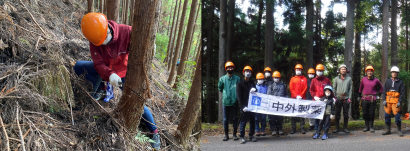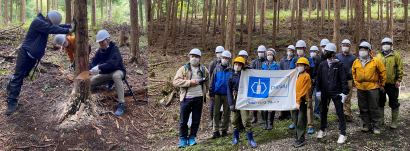Nov 30, 2022
Contribution to Global Environmental Protection - Efforts to protect water resources through forest maintenance at our production site -
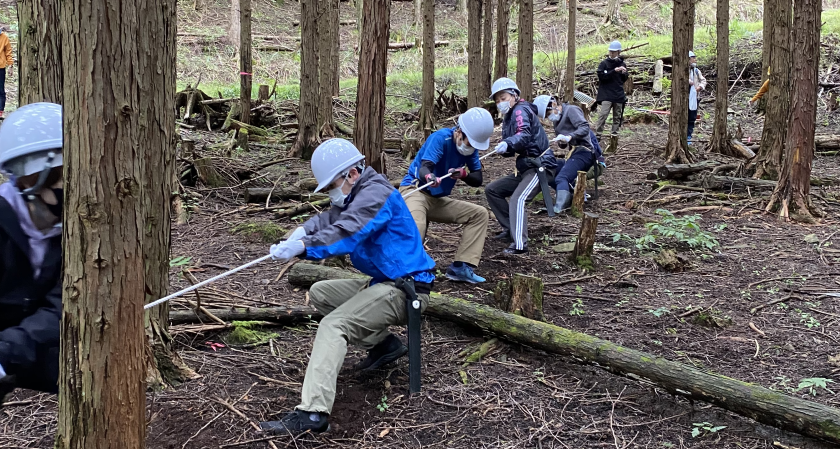
As part of its goal of contribution to global environmental protection as stated in “the Chugai Group Code of Conduct (CCC)”, the Chugai Group is actively promoting efforts to minimize our impact on the global environment. One of our goals is to build a sound water circulation system as part of our business activities to ensure the effective use of water, which is both an essential raw material in drug manufacturing and a globally important resource.
For more information on "the Chugai Group Code of Conduct (CCC)", click here.
As part of that effort, since 2019, we have been conducting volunteer forest preservation project in Kawanehoncho, Shizuoka Prefecture, the source of water used at our Fujieda Plant. In 2022, again on November 4, employees from the Fujieda Plant and their families undertook thinning work1) under the direction of the non-profit organization Kawane Life.
Since 2022, Chugai Group has also expanded its efforts to protect water resources to Chichibu County, Saitama Prefecture, which serves as a water source for our Ukima Plant, and on October 9, employees and their families of the company thinned trees under the direction of the Saitama Agriculture and Forestry Corporation.
In addition to this work, tree planting, pruning and clearing of underbrush will make it possible to protect healthy forests that also serve a watershed conservation function2).
In addition to these activities, the Chugai Group is conducting wastewater quality tests based on law of wastewater and also conducting Total Effluent Toxicity (WET) tests3), a method of managing wastewater using bioresponse testing, to ensure the conservation of biodiversity in wastewater discharged from all of domestic plants and laboratories. The goal of this testing is to provide comprehensive confirmation that wastewater discharged from Chugai Group facilities does not impact the natural environment.
Water source conservation activities at production sites will be developed into activities to conserve water resources for the future as well as wastewater management. In addition to reducing the amount of water used in its production activities and managing wastewater, the company is also volunteering in its forest conservation activities to not only minimize the impact of our company's production activities on the global environment, but also to contribute to the conservation of abundant water resources used jointly with the people living in the watershed.
These activities will also lead to meeting SDGs targeting safe water and conservation of both sea and land.
In our business activities, the Chugai Group uses water with care and releases it back into nature in a clean state, and by continuing with efforts to maintain the forests that nurture clean water, we will contribute to building a society in symbiosis with nature.
1) Tree thinning: Work designed to prevent forests from becoming overgrown, leading them back to health by cutting down certain trees to maintain appropriate density. Thinning allows sunlight to reach the individual trees, while also encouraging the growth of shrub, leading to a healthier forest.
2) Watershed conservation function: As trees put down solid roots in the earth, this ensures that rather than immediately flowing away, rainwater soaks deep into the earth (soil) where it becomes a source of slow-flowing groundwater. This prevents soil runoff, alleviates flooding and drought, and ensures all of us of a supply of clear, clean water.
3) Whole effluent toxicity test: A method for evaluating toxic effect of substances mixed in with wastewater by measuring the bioresponses of three types of aquatic life, including algae, crustaceans (Daphnia) and fish. This allows for an evaluation of combined impact, rather than the effect of individual substances in the wastewater.
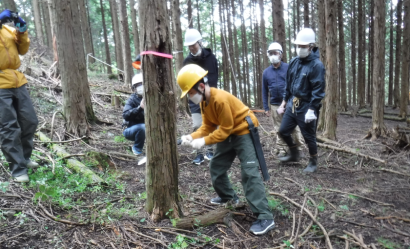
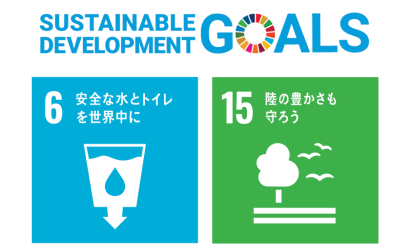
A comment from a participant in forest conservation volunteer activities
Mr. Yugo Fukuhara
HR Planning Group, Human Resources Management Department
What led me to participate in this activity was my fifth-grade son's summer vacation research project. At “the Water and Green Fureaikan in Okutama”, which we visited together, we learned how tap water, which we normally use as a matter of course, is maintained, and learned for the first time about the role of the headwater forest and the activities of everyone in the water authority who works hard to maintain it. This led my son to take an interest in forest conservation activities, and we both became involved.
We actually participated in the forest conservation activities, and my son also felt the hard work and passion of the people who struggle every day to maintain the source forest, and he seems to have become more motivated to treat the importance of water and resources with care. We would love to participate again if we have the chance.

